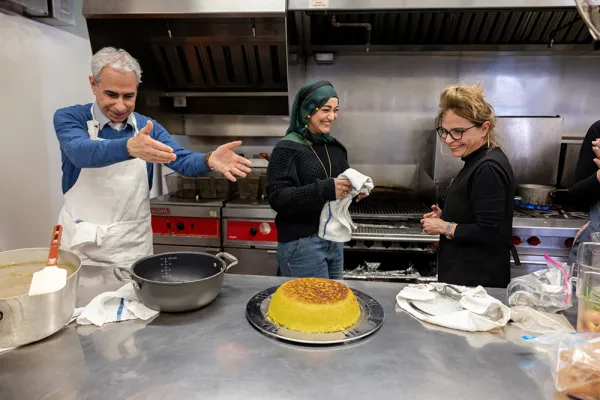A Recipe for Studying the Middle East
Smith Quarterly
For students in Professor Suleiman Ali Mourad’s new class, the kitchen is a lab
From left, Professor Suleiman Ali Mourad, Rinal Dahhan ’27, and Professor Mahnaz Mahdavi prepare tahdig, a Persian rice dish, in class.
Published April 28, 2025
It’s late morning in the Comstock House kitchen, and since lunchtime is not far off, there are quite a few cooks at various stations—chopping, blending, and sauteing an intriguing selection of meats, vegetables, herbs, and spices. But the delicious aromas hanging in the air are not the result of the Smith dining staff’s culinary magic. Rather, students in Professor Suleiman Ali Mourad’s Food, Identity, and Religion in the Middle East class are the ones cooking up today’s lunchtime delights.
Mourad, who also serves as the class’s head chef, says the course looks at the intricately connected history, religion, and culture of the Middle East through the lens of food and how various influences from the region can be seen worldwide. Lectures lay the foundation for what will be on the menu each week when the class meets in the Comstock House kitchen. Students cook several dishes from scratch, then gather in the dining room to enjoy the meal together—often bringing class discussions to the table to continue talking about significant aspects of the foods they have just prepared.
“Topics that seem to be so pedestrian can open us up to a very rich, complex world—this is the human experience in a nutshell,” Mourad says. “Food is about our belief systems, our identity, culture, economics, politics, biology, environment, art—it’s about pretty much everything.”
Mourad grew up in Lebanon and traces his interest in cooking back to his mother, a “fabulous” cook. As the oldest child in the family, he was obliged to help her in the kitchen, he says, which was “a blessing in disguise.” In 2012, on a sabbatical year in Nantes, France, he befriended some local chefs and learned some of their secrets. His love of cooking served as the foundation for Food, Identity, and Religion in the Middle East, which was offered at Smith for the first time this spring and is partially funded by the Center for the Environment, Ecological Design, and Sustainability (CEEDS). “This course embodies the interdisciplinary nature of environmental and sustainability issues, and we were very excited to support it,” says Joanne Benkley, associate director of CEEDS and of the environmental science and policy program. “Professor Mourad and his students are exploring food and sustainability, food and seasons, and new debates about religion and the environment as it relates to food and food production and consumption. Its experiential nature was a bonus.”
Today, the class is preparing maghmour (grilled eggplant and chickpeas in tomato sauce), arayes kafta (pita stuffed with seasoned ground meat), manakish za’atar (a blend of herbs and spices on flatbread), hummus with tahini, and pita bread. “The kitchen is essential,” Mourad says, “because sometimes you cannot theoretically teach something.”
“The kitchen is essential because sometimes you cannot theoretically teach something.”
Mourad spent last summer doing recipe testing for the class and determining the skill level necessary to make each dish and cook the whole meal from scratch within the allotted time. As the students work in small groups at each station, Mourad quickly makes the rounds, offering advice and pointing out correlations to topics discussed in the classroom. “The kitchen is a lab,” he says, “and as in biology, chemistry, and engineering, the lab makes the students realize the actual practice of doing something. They see it, they touch it, they feel it, they smell it. In this case, they taste it.”
African studies major Uchechi Anaba ’27 echoes many of the students’ praise for the participatory component of the class. “I love that it is a really hands-on way to learn about history, religion, and economics,” Anaba says. “We need more classes like this.”
In true multidisciplinary form, guest lecturers from a variety of fields are invited to the class. Engineering lecturer Michael Kinsinger is on hand today to talk about the science behind flatbread. “How you go about transforming the wheat kernel into something usable like bread is a process of chemistry, and engineering is just the manipulation of that chemistry,” Kinsinger says. “How we mix things, how long we cook things at what temperatures—that’s all engineering.”
For those not fortunate enough to experience Food, Identity, and Religion in the Middle East firsthand, a website offers recipes and a podcast. History major Midge Hayward ’25 is assisting with the website, while English language and literature major Eli Chuharski ’25 is working on the podcast. “This course is truly groundbreaking, and, much like cooking, this combination of theory and practice results in something far greater than the sum of its parts,” Chuharski says. “We created the podcast and website with this in mind, and we wanted to reinforce the longevity and accessibility of the course—our own way of contributing to the living archive of food research.”
Mourad has some exciting ideas for future iterations of the class, such as a visit to Smith’s botanic garden, where most of the spices and herbs used in the class are grown. He is also working on a book, A Lebanese Food Comedy, that will feature stories based on the relationship between food and the people in the small village in south Lebanon where he grew up. “Their life revolved around the land and what they could grow or forage, depending on the season,” Mourad says. “They were poor cash-wise, but they were rich in agricultural produce and shared it with their relatives and friends. The book honors that relationship of people to their land and to their natural, human, and supernatural environments.”
